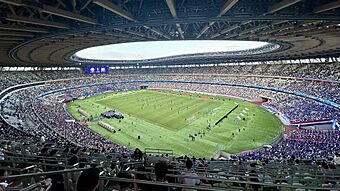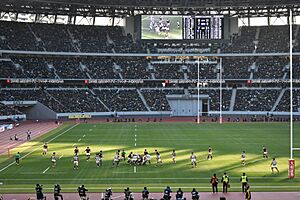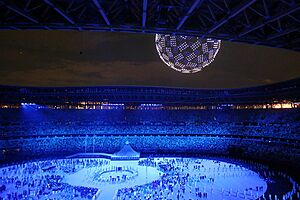Japan National Stadium facts for kids
|
国立競技場
|
|
 |
|
| Full name | Japan National Stadium |
|---|---|
| Location | 10-2, Kasumigaoka-machi, Shinjuku, Tokyo, Japan |
| Coordinates | 35°40′41.5″N 139°42′52.5″E / 35.678194°N 139.714583°E |
| Public transit | |
| Owner | Japan Sport Council |
| Capacity | 67,750 80,016 (football and rugby,with temporary seats over running track) |
| Field size | 107 × 71 m |
| Surface | Grass |
| Construction | |
| Broke ground | 11 December 2016 |
| Built | December 2016 – 30 November 2019 |
| Opened | 21 December 2019 |
| Construction cost | US$1.4 billion (¥157 billion) |
| Architect | Kengo Kuma |
| Tenants | |
| Japan national football team Japan national rugby union team |
|

The Japan National Stadium, also known as the National Stadium (国立競技場, Kokuritsu Kyōgijō), is a huge sports arena in Tokyo, Japan. People sometimes called it the "Olympic Stadium" during the 2020 Summer Olympics and 2020 Summer Paralympics. It's a multipurpose stadium, meaning it can be used for many different sports, but it's mostly known for association football (soccer).
This stadium was the main place for the opening and closing ceremonies of the 2020 Summer Olympics and Paralympics in 2021. It also hosted all the exciting track and field events.
The old National Stadium was taken down in May 2015. Construction for this new, amazing stadium began on December 11, 2016, and it was finished on November 30, 2019.
Contents
Building the New National Stadium
Why Tokyo Needed a New Stadium
When Tokyo wanted to host the 2020 Summer Olympics, they needed a top-notch stadium. The old one was good, but it was decided that a brand new, modern stadium would be even better. This new stadium would host the big opening and closing ceremonies, plus all the fast-paced track and field events.
In 2012, plans were made to tear down the old stadium and build a new one. The first design was by a famous architect named Zaha Hadid. The new stadium was supposed to be ready by March 2019. It would be used for athletics, rugby, some football games, and the Olympic ceremonies.
Changes to the Original Design
Building a stadium this big is a huge project, and sometimes plans change! In 2015, the Japanese government decided to make some changes to the first design. They needed to keep the costs down. For example, they decided not to build a roof that could open and close. They also planned to use some temporary seats instead of all permanent ones.
Some Japanese architects thought the first design looked a bit strange, comparing it to a turtle. Others worried it was too big for the area. The roof was especially tricky to build because it needed two very long steel arches. The estimated cost was also very high.
A New Plan and Architect
Because of the high costs and public concerns, the Japanese Prime Minister, Shinzō Abe, decided in July 2015 to scrap the first design. They started over with a new competition to find a different design. This meant the stadium wouldn't be ready for the 2019 Rugby World Cup as first planned.
In December 2015, a new design by architect Kengo Kuma was chosen. This design used lots of wood, which is a special feature of the stadium today. Construction began in December 2016 and was completed on November 30, 2019.
Ready for the Olympics
The new stadium was officially opened on December 21, 2019, with a special ceremony. The very first sports event held there was the 2019 Emperor's Cup final on January 1, 2020.
The stadium was all set for the 2020 Summer Olympics and Paralympics. However, due to the COVID-19 pandemic, most events were held without spectators.
In October 2021, Japan decided to keep the athletics track permanently. This means the stadium can host more track and field events in the future. It's even bidding to host the 2025 World Athletics Championships! In May 2023, the stadium also hosted two exciting J. League football games.
Concerts and Events
The Japan National Stadium isn't just for sports! It's also a fantastic venue for big concerts. Many famous artists have performed here.
| List of concerts | ||||||
|---|---|---|---|---|---|---|
| Date | Main act(s) + opening act(s) | Tour/concert name | ||||
| 3 November 2020 (Taped at 23–24 Oct) | Arashi | Arafes | ||||
| 27–28 August 2022 | Eikichi Yazawa | EIKICHI YAZAWA 50th ANNIVERSARY TOUR"MY WAY" | ||||
| 27–28 April 2024 | Ado | Ado SPECIAL LIVE 2024「心臓」 | ||||
| 19–20 April 2025 | Snow Man | Snow Man 1st Stadium Live~Snow World~ | ||||
International Football Matches
This stadium has hosted several exciting international football matches, bringing teams from around the world to Tokyo.
| Date | Competition | Team1 | Result | Team2 | Attendance |
|---|---|---|---|---|---|
| 6 June 2022 | Friendly | 0–1 | 63,638 | ||
| 24 March 2023 | Friendly | 1–1 | 61,855 | ||
| 1 January 2024 | Friendly | 5–0 | 61,916 | ||
| 21 March 2024 | World Cup qualifier | 1–0 | 59,354 |
Unique Features of the Stadium
The Japan National Stadium is special because it uses a lot of wood in its design. This wood comes from all over Japan, which helps reduce its environmental impact. The wooden parts are designed so they can be replaced easily if needed.
The design of the roof's edges was inspired by an ancient Japanese temple called Hōryū-ji. These eaves have spaces that help air flow through the stadium, keeping it cool. The roof also has transparent solar panels that collect energy from the sun. Rainwater is collected and used to water the grass and plants around the stadium.
Making sure everyone can use the stadium was very important. There are over 450 spots for wheelchair users and modern, accessible toilets.
Images for kids
Construction
See also
 In Spanish: Estadio Olímpico de Tokio (2019) para niños
In Spanish: Estadio Olímpico de Tokio (2019) para niños




















